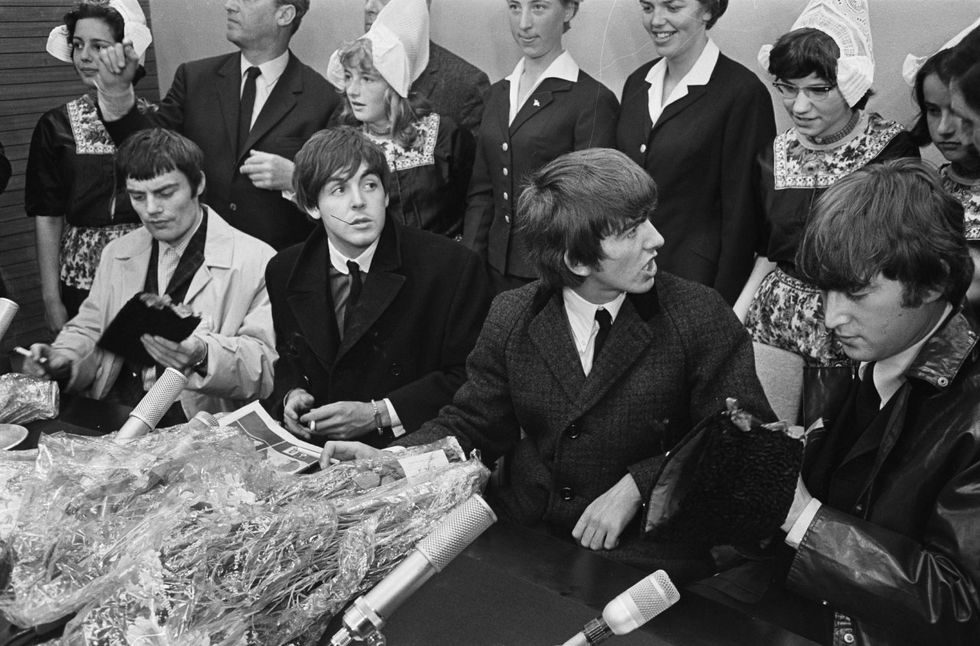More recently, eugenics is a hotly contested debate throughout written history. Do we need a supreme race? Are we playing God? Are eugenics as a science morally right? Authors are currently writing about eugenics in many different ways, but it did not start out that way. Eugenics has also been seen in scientific culture, especially in the 1930’s when Hitler’s regime in Germany used eugenics to create a superior race.
Around this time, eugenics was written about as an incredible scientific advancement that could be used to weed out those who scientists and government officials felt were useless to society. Many people focused their attention on this aspect, this specific part of the world including Germany and most of eastern Europe. Society had failed to realize that it had been going on in other parts of the world.
Why, you may ask? The reason is because it was happening to women, who were largely unspoken about throughout history. They were usually written into history according to their male counterparts, with the occasional mention of a woman who had achieved some significant feat. But what about the everyday woman, where was her voice? She was not written about in regards to eugenics until the 1970’s and 1980’s, when women’s history was coming to the forefront. Most authors focused on one specific atrocity: what had happened to women in Puerto Rico as a result of their colonization by the United States. The writing of eugenics as a subject took many significant turns throughout history: first being written as a medical advancement or achievement, then as a tool to be used to make a superior race, and recently as a contribution to the study of women’s history. These shifts in portrayal of the subject show either affinity for women or lack of affinity for women.
Popenoe and Johnson’s book was written in 1918, upon the ending of World War I, when a specific group of people came to power in Germany. Those in power were consumed with the thought of creating a superior race: those who could work hard, contribute to society, and be used as soldiers for any reason that Germany might feel necessary. Touting newly discovered medical treatments, the authors delve deep into scientific study. They examine whether people’s behavior is determined by how they are nurtured, or if nature is the main determinant. They then delve into genetics, and how genes can be modified in order to achieve specific attributes: meaning hair color, eye color, and other human features. What is especially troublesome is when they speak about how traits are carried to children from their mothers.
“If a mother’s mental and physical condition be good, the supply of nourishment to the embryo is likely to be good, and development will be normal. If, on the other hand, the mother is constantly harassed by fear and hatred, her physical health will suffer, she will be unable properly to nourish her developing offspring, and it may be that the child’s poor physical condition when born will indicate this.”
This general disregard for women speaks volumes. It is exactly this type of thinking that led many to believe that genetic traits were solely the responsibility of the woman, and the man had no bearing on a child’s deficiencies. The next chapter of the book is dedicated to men, specifically laying out in detail their superiority when it came to their genes. Though the book has some clearly written doctrines on genetics with some pretty looking graphs, looking at it from the future, you can see how medically untrue it actually is. Popenoe and Johnson give a clear example in Chapter 5, where they state: “Obviously a race will be steadily improved, if the worst stock in it is cut off before it has the chance to reproduce, and if the best stock survives to perpetuate its kind.” As a person looking from the future, we know this is absolutely untrue. Yet this was the type of medical advancement of the time that common people swore by.
The book is dominated with racism, especially when speaking of the inhabitants of Puerto Rico. A little before this book was written, in 1898, Puerto Rico became a commonwealth of the United States. As such, those who inhabited the island were considered American citizens and had the same rights as those living on the mainland. Popenoe and Johnson felt the issue was that those who emigrated to the mainland had no intention of repatriating. Their bigotry and racism is clear. They state that “its one-half million inhabitant, a large part of whom have at least some Negro blood”.
This trend continued throughout the eugenics movement, all the way up until the 1980’s. In Germany they even went as far as to not only alter genetics, but to euthanize and sterilize those that they deemed “unfit” for their society. Puerto Rico did not go as far as to euthanize women, but they were most certainly sterilized. This became evident through written works throughout the 1960’s, when eugenics became the sort of movement characterized by social, political, and demographic changes. It was no longer written about as a science, although science was certainly the way it started.
Between 1910 and 1950, Puerto Rico experienced a population surge. The population almost doubled in size from before 1910. The density of people was twelve times as high as that of the continental United States. Back, Hill, and Stycos attribute this to an influx of capital from the mainland as well as significant agricultural advancements and social welfare programs. They then start to explain social statistics and demographic changes throughout the island, laying out birth rates and death rates among the people of Puerto Rico. Being that Puerto Ricans were considered citizens of the United States, the government gave them permission to travel to live and work in major cities: specifically New York, Chicago, and Philadelphia. This helped to control the population on the island for a little while, but more steps were thought to be necessary to decrease population numbers.
Eugenics was formally introduced into Puerto Rico in the 1920’s, though many of the people living there were vehemently opposed to it due to their strong Catholic values. By 1935, as the previous population reached old age and younger people were having babies, they were able to open around thirty-five birth control clinics on the island. Though it was successful in drawing people in, the women who visited did not follow instructions and frequently became pregnant. Here, the blame is evidently placed on women in regards to the population explosion.
Further into the future, around the late 1930’s, women were openly advocating for and requesting access to birth control. While laws were passed on the island regarding this, Washington D.C., who ultimately signed off on the laws governing Puerto Ricans, dragged their feet, making it harder and harder for women to have access to birth control. Thus, the population continued to expand. Around eighty percent of Puerto Rican women knew of the clinics locations by the 1950’s, even those in rural areas. Women were being targeted as recipients of birth control because they were women. This is clear when the author speaks of what is known as “machismo”, a primal male need to secure many offspring to leave his mark on earth and carry on the family name.
Sterilization was the most commonly used form of eugenics in Puerto Rico. It came about due to the fact that “The lack of norms against family limitation and of norms either for or against large families, the freedom to use contraception without a strong effort to promote the use, the late acquisition of knowledge about contraception, and concern about family size among many women”. From 1944-1950, sterilization in Puerto Rico nearly doubled. The operation was cheap and effective at what it was set out to do. Due to a blood shortage, those who did not have the money could have the operation done for as little as two donations.
The sad part of the whole movement in Puerto Rico was the lack of education for women. They were originally told that birth control was a option, but were not necessarily properly educated on how to use it. Sterilization eventually became so commonplace that it began to be referred to as “la operacion”. Most women were not being told exactly what was happening to them. They thought the surgery could be reversed if they wanted to have more children in the future.
As the 1970’s came about, another shift is seen in the historiography of eugenics, especially when it came to the women of Puerto Rico. Bonnie Mass’s article on eugenics in Puerto Rico is descriptive when it comes to the use of eugenics in Puerto Rico in social terms. Unemployment during the 1930’s was very high as a result of the Great Depression, which had trickled down into the territories of the United States after it had hit the mainland. Official support for the use of eugenics was given at this time for use in Puerto Rico, although it is claimed by many that it stemmed from overpopulation, when the issue behind the issue was actually unemployment.
Mass also highlights the sneaky tactics used by doctors as described before. If a woman came into a hospital to give birth to a baby, she was immediately sterilized afterwards. This way they could control the number of children a woman had and how often she had to come to the hospital to give birth. It was their way of curbing population and spending more money for each woman’s hospital visit with each subsequent child, as well as curbing population numbers for further future unemployed Puerto Ricans. Most women who had this happen to them were never even told about the surgery, as it usually happened when they were knocked out from giving birth. They only realized what had been done to them when they were not able to conceive another child.
The director general of the United Nations would even go as far as to say that population increase was worse than war when it came to the fate of a nation. As a result of this vicious push to control the population, by the 1940’s, twenty-one percent of Puerto Rican women had been sterilized. To those that governed, eugenics became a geopolitical strategy. Puerto Rico was used many times by the United States as a defense for their battles in the Caribbean. To cut down the loss of life and to make sure they had able-bodied people fighting on their side, they chose to cut down Puerto Rico’s population. After these offenses, by 1975, more than one-third of the women had been sterilized.
This trend of sterilization and eugenics continued until about the 1970’s. The 1960’s were a decade that was riddled with individuals and groups who consistently fought for civil liberties, things that they felt were their ultimate right as a human being. This was particularly true for those who lived in Puerto Rico, as those who inhabited the island were increasingly stereotyped and seen as “other”. Puerto Ricans began to become educated on public policy, as well as tactics used by the government to silence their voice.
In Laura Briggs's book Reproducing Empire, aside from the historical development of the topic, she dedicates a specific chapter to the movement of individuals and groups in Puerto Rico who fought for their individual rights. Stories of Puerto Ricans had hit library shelves and Broadway plays such as “West Side Story” were performed. All of this led to Puerto Ricans, especially women, becoming in tune with their femininity as opposed to how they were portrayed by the media. They were described as being “gross and grotesque” as well as supporting a “culture of poverty”. This book is key in examining the eugenics movement with regards to the response of the Puerto Rican people of this era. Rather than being a medical or governmental incident, it became a social one. Puerto Ricans, especially women, did not want the mainstream media garnishing their name.
The historiography of eugenics took another turn in the late 2000’s. More and more authors were trying to get a feel of what life was really like for those who had been sterilized, pointing out specific feelings on the issue and how it affected the everyday woman’s life in Puerto Rico. The women’s voices from the beginning of the movement may be missing due to the fact that it started as early as 1890, but those who experienced the issue from the 1950’s and onward had a lot to say on the subject. It is evident that this was happening to Puerto Rican women on the mainland as well, as a woman interviewed explained that after giving birth to her third child in Philadelphia she was subsequently sterilized without being notified. It is clear that these first person accounts led those who listened to them to have a deeper understanding of what these women were going through as well as being witnesses to an American atrocity.
Klausen, in her review article from 2009, takes a different approach in regards to the use of eugenics as it relates to a colonial system. She notes that there is a direct correlation between the imperialists and the colonials in regards to other imperialistic societies. The atrocities conducted took place in many different places that were colonized, but Puerto Rico was not spoken about due to the fact that it was an American colony. The women’s work life, sexuality, and personal bodies were something to be feared by Americans. They were labeled as being deviant, and common Americans as well as officials felt that the women would benefit from sterilization because it was necessary for Puerto Rican women to fit into the archetype of an American woman. Eugenics in Puerto Rico was also an important case-study on how people who were seen as straying from the norm could be puppets in a political game, and truly showed the feminist perspective on the issue. This colonial first person perspective was something that had not been seen in historiography until this time period.
Although eugenics is a topic that has been extensively written about throughout history, we have seen throughout time it has been written about in many different ways. Lauded as a scientific feat in the early twentieth century, it has transformed now, almost a hundred years later, into a subject that is discussed at length in many different ways. As time has progressed, positions have changed, and so has the way of writing on the subject. From science to interpersonal studies, to culture, geo-political agendas, social sciences, demographics, and first person accounts, and feminism, eugenics is an all encompassing topic throughout history. Without the shifts in historiography, we would not know all there is to know about the subject and the humans lives that it has affected would never have had a voice. These women are an integral part in the shaping of the eugenics movement not only in Puerto Rico and the United States, but of the world in and of itself. That is why we must disagree with a statement made by Meade: “it was never a progress that could encompass everyone, leaving in place, or even exacerbating, racial, class, and gender divisions”. Quite the contrary.
Bibliography
- Back, Kurt W, Reuben Hill, and J. Mayone Stycos. "Population Control in Puerto Rico: The Formal and Informal Framework.” Law and Contemporary Problems 25, no. 3 (1960): 558-576. Accessed April 14, 2016. http://www.jstor.org/stable/1190755.
- Briggs, Laura. Reproducing Empire : Race, Sex, Science, and U.S. Imperialism in Puerto Rico. Berkeley: University of California Press, 2002. (Lehman College)
- Johnson, Roswell Hill, and Paul Popenoe. Applied Eugenics. New York: The Macmillan Company, 1935. (Staten Island)
- Klausen, Susanne. "Review: Rethinking Reproduction: New Approaches to the History of Sexuality, Gender, the Family, and Reproductive Control.” Journal of Contemporary History 44, no. 1 (2009): 117-127. Accessed April 26, 2016. http://www.jstor.org/stable/40543077
- Kluchin, Rebecca M. "Locating the Voices of the Sterilized.” The Public Historian 29, no. 3 (Summer 2007): 131-144. Accessed April 20, 2016. http://www.jstor.org/stable/10.1525/
- Mass, Bonnie. “Puerto Rico: A Case Study of Population Control.” Latin American Perspectives 4, no. 4 (Autumn, 1977): 66-81. Accessed April 14, 2016. http://www.jstor.org/stable/2633177
- Meade, Teresa A. A History of Modern Latin America: 1800 to the Present. United Kingdom: Blackwell Publishing, 2010. (John Jay)





 Going to the cinema alone is good for your mental health, says science
Going to the cinema alone is good for your mental health, says science












 women in street dancing
Photo by
women in street dancing
Photo by  man and woman standing in front of louver door
Photo by
man and woman standing in front of louver door
Photo by  man in black t-shirt holding coca cola bottle
Photo by
man in black t-shirt holding coca cola bottle
Photo by  red and white coca cola signage
Photo by
red and white coca cola signage
Photo by  man holding luggage photo
Photo by
man holding luggage photo
Photo by  topless boy in blue denim jeans riding red bicycle during daytime
Photo by
topless boy in blue denim jeans riding red bicycle during daytime
Photo by  trust spelled with wooden letter blocks on a table
Photo by
trust spelled with wooden letter blocks on a table
Photo by  Everyone is Welcome signage
Photo by
Everyone is Welcome signage
Photo by  man with cap and background with red and pink wall l
Photo by
man with cap and background with red and pink wall l
Photo by  difficult roads lead to beautiful destinations desk decor
Photo by
difficult roads lead to beautiful destinations desk decor
Photo by  photography of woman pointing her finger near an man
Photo by
photography of woman pointing her finger near an man
Photo by  closeup photography of woman smiling
Photo by
closeup photography of woman smiling
Photo by  a man doing a trick on a skateboard
Photo by
a man doing a trick on a skateboard
Photo by  two men
two men  running man on bridge
Photo by
running man on bridge
Photo by  orange white and black bag
Photo by
orange white and black bag
Photo by  girl sitting on gray rocks
Photo by
girl sitting on gray rocks
Photo by  assorted-color painted wall with painting materials
Photo by
assorted-color painted wall with painting materials
Photo by  three women sitting on brown wooden bench
Photo by
three women sitting on brown wooden bench
Photo by 
 Photo by
Photo by  Photo by
Photo by  Photo by
Photo by  Photo by
Photo by 


 people sitting on chair in front of computer
people sitting on chair in front of computer











